By Courtney Gosse
Introduction
The Institute for Global Understanding (IGU) co-hosted a film discussion based on Ravi Kumar’s 2014 film, Bhopal: A Prayer for Rain, as part of the 2020-2021 World Cinema Series on January 26 at 7:30 p.m. This event was moderated by Dr. Thomas Pearson, Professor in the Department of History and Anthropology. The faculty discussants for this film were Dr. Datta Naik, Professor of Chemistry, and Dr. Marina Vujnovic, Associate Professor of Communication a nd a specialist in global communications.
nd a specialist in global communications.
The film was released on the 30th anniversary of the Union Carbide disaster, which occurred December 2-3, 1984 in Bhopal, India. The film analyzes the causes of the chemical leak and vapor spread that killed as many as 10,000 people in Bhopal, along with Union Carbide corporate leadership’s responsibility, its local operatives in Bhopal, and local officials’ complicity in creating the conditions that led to the environmental catastrophe, their efforts to avoid accountability, and the disaster’s legacy. The film allows viewers to adequately examine the interdependence among human communities and the natural world; if one side of the relationship is affected, both sides then become affected. As disasters continue to persist today, due to climate change and human errors, there are many lessons that can be learned from analyzing what is considered the world’s worst industrial disaster: the catastrophe of Bhopal.
Information About the Film
The director, Ravi Kumar, is a famous Bollywood actor and director. He was inspired to make the film as early as 2004 after reading Sunjoy Hazarika’s Bhopal, the lessons of a tragedy. He discovered that few members of the younger generations knew about the Bhopal disaster, which fascinated him, and pushed him to believe that this was a film that needed to be made.
In 2010, unfortunately, Kumar ran into the problem of getting the film released. His efforts to release the film were plagued by controversy as the Dow Chemical company, which acquired what had been Union Carbide in 2001, blocked efforts to screen the film. Local activists in Bhopal also had real concerns about the film’s message. However, this did not stop Kumar from completing the film’s production. Next, when the film was considered complete, Kumar then faced another problem: getting a distributor to finance the film’s release. A film in which thousands of people died in the most horrible ways would prove to be a difficult endeavor in this regard. Kumar eventually managed, with the help of actor Martin Sheen, to screen the film at a few different international film festivals. As a result of these events, the film began attracting a larger audience, which simply provided more attention to the Bhopal tragedy. Therefore, Kumar decided to show the film on the 30th anniversary of the event with a premiere in Bhopal.
Discussion with Dr. Datta Naik about Toxicity
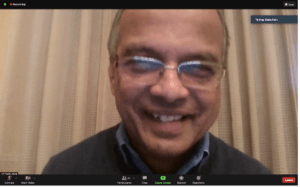 Dr. Naik provided viewers with an explanation of what happened logistically regarding the Union Carbide product’s toxicity and why it had killed so many people in Bhopal in 1984. To begin, Union Carbide was making and selling a toxic pesticide, Sevine, made from MIC (methyl isocyanate), which was made at the plant, and 1-naphthol, which was outsourced from another location. The chemical compound MIC is extremely toxic; the threshold limit value set by the American Conference on Government Industrial Hygienists is 0.02 parts per million (ppm). Although the MIC’s odor cannot be detected at 5 ppm by most people, its potent lachrymal properties provide an excellent warning of its presence. (At 2-4 ppm, subjects’ eyes are irritated, the first sign of exposure.)
Dr. Naik provided viewers with an explanation of what happened logistically regarding the Union Carbide product’s toxicity and why it had killed so many people in Bhopal in 1984. To begin, Union Carbide was making and selling a toxic pesticide, Sevine, made from MIC (methyl isocyanate), which was made at the plant, and 1-naphthol, which was outsourced from another location. The chemical compound MIC is extremely toxic; the threshold limit value set by the American Conference on Government Industrial Hygienists is 0.02 parts per million (ppm). Although the MIC’s odor cannot be detected at 5 ppm by most people, its potent lachrymal properties provide an excellent warning of its presence. (At 2-4 ppm, subjects’ eyes are irritated, the first sign of exposure.)
 Next, MIC was created in large quantities at the Union Carbide plant and needed to be kept cool (near the freezing point) when not in use, which was the case in Bhopal. The chemical was then kept in large 60-ton tanks while waiting to be utilized properly. The chemical leak started from these storage tanks due to lack of specific protocols being followed, as well as the event itself, which was the MIC reacting with other chemicals and escaping into the atmosphere. Several protocols were not followed: (1) the tank’s refrigeration was off, (2) one out of the three tanks was empty, and (3) the other two tanks
Next, MIC was created in large quantities at the Union Carbide plant and needed to be kept cool (near the freezing point) when not in use, which was the case in Bhopal. The chemical was then kept in large 60-ton tanks while waiting to be utilized properly. The chemical leak started from these storage tanks due to lack of specific protocols being followed, as well as the event itself, which was the MIC reacting with other chemicals and escaping into the atmosphere. Several protocols were not followed: (1) the tank’s refrigeration was off, (2) one out of the three tanks was empty, and (3) the other two tanks  were filled more than halfway (~30 tons of MIC). The chemical reaction that took place was due to an operation error during the rinsing of the vent pipes; water flowed into the MIC storage tank, which is when everything started to go wrong. An exothermic reaction between MIC and water occurred, producing intense heat in the tank’s confined space. The temperature and pressure started to rise, which caused part of the MIC distillates to decompose and to generate hydrogen chloride gas. This gas formed hydrochloric acid with water (another exothermic reaction) and corroded the stainless-steel tank, dissolving it into iron. The dissolved iron, acting as a catalyst, caused a trimerization reaction to produce trimethyl isocyanate (a solid). This trimerization reaction did not go into the atmosphere, but rather was exothermic and produced extreme heat, which simply increased the temperature and pressure in the tank, reaching 250 °C (482 °F), causing the tanks to rupture. Eventually, the toxic MIC gas along with several other toxic gases, all heavier than air, leaked out of the tank and into the plant, and then finally into the low atmosphere of Bhopal.
were filled more than halfway (~30 tons of MIC). The chemical reaction that took place was due to an operation error during the rinsing of the vent pipes; water flowed into the MIC storage tank, which is when everything started to go wrong. An exothermic reaction between MIC and water occurred, producing intense heat in the tank’s confined space. The temperature and pressure started to rise, which caused part of the MIC distillates to decompose and to generate hydrogen chloride gas. This gas formed hydrochloric acid with water (another exothermic reaction) and corroded the stainless-steel tank, dissolving it into iron. The dissolved iron, acting as a catalyst, caused a trimerization reaction to produce trimethyl isocyanate (a solid). This trimerization reaction did not go into the atmosphere, but rather was exothermic and produced extreme heat, which simply increased the temperature and pressure in the tank, reaching 250 °C (482 °F), causing the tanks to rupture. Eventually, the toxic MIC gas along with several other toxic gases, all heavier than air, leaked out of the tank and into the plant, and then finally into the low atmosphere of Bhopal.
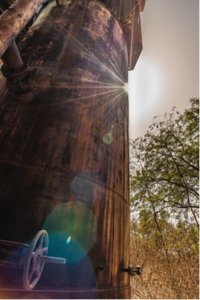 Lastly, due to misinformation and lack of education regarding the chemicals being held and produced at Union Carbide, essential workers, staff members, and even the local community knew nothing about how to treat the symptoms that were present during the gas leak. Also, Union Carbide had not conducted emergency drill or training prior to the incident, which is unfortunate because all that needed to be done to escape the inhalation of the toxic gas was to run to higher ground. Therefore, due to lack of education and training, thousands of people were then greatly affected by this horrific event. In fact, the official immediate death toll was 2,259. Then, in 1991, after being reassessed, the total count was 3,928 deaths. However, unofficial total deaths are estimated to be around 14,410. Also, the amount of people injured during this event is estimated to be 574,000. To put this into perspective, Bhopal’s population in 1984 was 850,00; therefore, over half of the population was affected. Overall, there were many potential efforts that could have prevented this disaster.
Lastly, due to misinformation and lack of education regarding the chemicals being held and produced at Union Carbide, essential workers, staff members, and even the local community knew nothing about how to treat the symptoms that were present during the gas leak. Also, Union Carbide had not conducted emergency drill or training prior to the incident, which is unfortunate because all that needed to be done to escape the inhalation of the toxic gas was to run to higher ground. Therefore, due to lack of education and training, thousands of people were then greatly affected by this horrific event. In fact, the official immediate death toll was 2,259. Then, in 1991, after being reassessed, the total count was 3,928 deaths. However, unofficial total deaths are estimated to be around 14,410. Also, the amount of people injured during this event is estimated to be 574,000. To put this into perspective, Bhopal’s population in 1984 was 850,00; therefore, over half of the population was affected. Overall, there were many potential efforts that could have prevented this disaster.
Discussion with Dr. Vujnovic on Corporate Social Responsibility
 Dr. Vujnovic helped viewers better understand Union Carbide’s failure to exercise responsibility (now called Dow Chemical Company) for this event that occurred more than three decades ago. She also explained how the attitude portrayed toward this disaster, along with the lack of a coordinated response, shows exactly how not to do crisis management: “delayed, denied, and deflected.” The story of Bhopal is simply about collusion between governments (both Indian and American), along with large corporate powers. The groups involved continue to obstruct justice for the Bhopal disaster’s victims due to lack of enforcement regarding liability. For example, even today, the company continues to refuse to provide basic information regarding the disaster to reporters, constantly giving excuses and blaming the local government as well as the Bhopal community for the crisis. However, legal documentation indicates that everything is traced back to Warren Anderson, the former CEO of Union Carbide. Anderson had signed the paperwork knowing that there would be safety issues at the Bhopal location simply for the purpose of cost-saving measures. The documents eventually surfaced in 1981 proving this, along with the number of employees hired and fired, as well as the lack of safety training protocols throughout the company’s locations.
Dr. Vujnovic helped viewers better understand Union Carbide’s failure to exercise responsibility (now called Dow Chemical Company) for this event that occurred more than three decades ago. She also explained how the attitude portrayed toward this disaster, along with the lack of a coordinated response, shows exactly how not to do crisis management: “delayed, denied, and deflected.” The story of Bhopal is simply about collusion between governments (both Indian and American), along with large corporate powers. The groups involved continue to obstruct justice for the Bhopal disaster’s victims due to lack of enforcement regarding liability. For example, even today, the company continues to refuse to provide basic information regarding the disaster to reporters, constantly giving excuses and blaming the local government as well as the Bhopal community for the crisis. However, legal documentation indicates that everything is traced back to Warren Anderson, the former CEO of Union Carbide. Anderson had signed the paperwork knowing that there would be safety issues at the Bhopal location simply for the purpose of cost-saving measures. The documents eventually surfaced in 1981 proving this, along with the number of employees hired and fired, as well as the lack of safety training protocols throughout the company’s locations.
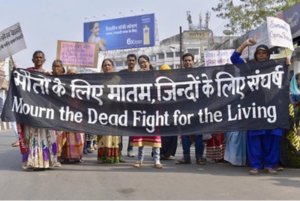 Another example of corruption is the settlement to which Union Carbide agreed with the U.S. and Indian governments. The company agreed to this settlement to save its image and reputation, but the money was given to the Indian government to provide each victim and family with proper compensation (around $1,000 per victim). However, the Indian government enacted the Bhopal Gas Leak Disaster Act in 1985, which enabled the government to act as a legal representative for the victims. Therefore, once this money was paid, the Indian government did not give all the money to the victims and instead kept most of the estimated $370 million in its own coffers. The victims and their families continue to campaign in the hope that they will one day receive proper compensation for the disaster.
Another example of corruption is the settlement to which Union Carbide agreed with the U.S. and Indian governments. The company agreed to this settlement to save its image and reputation, but the money was given to the Indian government to provide each victim and family with proper compensation (around $1,000 per victim). However, the Indian government enacted the Bhopal Gas Leak Disaster Act in 1985, which enabled the government to act as a legal representative for the victims. Therefore, once this money was paid, the Indian government did not give all the money to the victims and instead kept most of the estimated $370 million in its own coffers. The victims and their families continue to campaign in the hope that they will one day receive proper compensation for the disaster.
 On a more positive note, although there was a lack of global support and attention given to the Bhopal disaster, a nonprofit organization, the Chingari Trust, continues to help combat the disaster’s effects on the local community. Founded by survivors Rashida Bee and Champadevi Shukla in 2006, the organization provides economic and livelihood support programs primarily to women and children in the affected area.
On a more positive note, although there was a lack of global support and attention given to the Bhopal disaster, a nonprofit organization, the Chingari Trust, continues to help combat the disaster’s effects on the local community. Founded by survivors Rashida Bee and Champadevi Shukla in 2006, the organization provides economic and livelihood support programs primarily to women and children in the affected area.
Overall, what can be taken from this film and the event that it depicts is that there is absolutely no justice without proper accountability. Multinational corporations, like Union Carbide, always seem to be in the race for the bottom line, yet, where are the ethics in this approach? It seems that the bottom line is always put first, before human decency or proper respect for human rights. The U.S. approach to conducting international business must change. It cannot be about what is allowable; it needs to be about what is a proper and safe way of conducting business (i.e., protecting people and protecting the environment). Although the role of governments is important in these situations, the ultimate responsibility lies with the corporations themselves. It is simple: Do not take advantage of vulnerable communities and adopt ethical practices in your work.
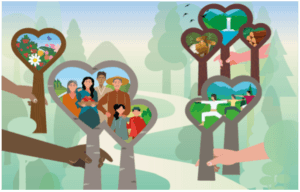 On the United Nations website, a summary of the International Day of Forests stresses the necessity of healthy, flourishing forests of all types across the globe. Despite the infinite benefits forests provide the Earth, its ecosystems, climate, and resources, deforestation continues, and the human population remains unaware of the devastating effects that will soon result. Thus, the theme for this year’s International Day of Forests is “Forest Restoration: A Path to Recovery and Well-Being.” Reforestation and forests’ sustainability are crucial to combating the ever-worsening crisis of climate change and threats to biodiversity.
On the United Nations website, a summary of the International Day of Forests stresses the necessity of healthy, flourishing forests of all types across the globe. Despite the infinite benefits forests provide the Earth, its ecosystems, climate, and resources, deforestation continues, and the human population remains unaware of the devastating effects that will soon result. Thus, the theme for this year’s International Day of Forests is “Forest Restoration: A Path to Recovery and Well-Being.” Reforestation and forests’ sustainability are crucial to combating the ever-worsening crisis of climate change and threats to biodiversity. Professor Abate identified the dual efforts for reforestation and sustainable management as the solution to all the issues affecting forests. Reforestation and afforestation are both necessary; reforestation refers to rebuilding forests in places they once existed, and afforestation is the introduction of forests to locations where they did not previously exist. These healthy, thriving forests’ presence will serve as a hub for increased biodiversity and are a valuable weapon in mitigating and adapting to climate change. A healthy ecosystem is resilient, and its resilience can better adapt to the effects of climate change. Moreover, photosynthesis in forests draws carbon out of the air, which makes intact forests valuable carbon sinks in the fight against climate change.
Professor Abate identified the dual efforts for reforestation and sustainable management as the solution to all the issues affecting forests. Reforestation and afforestation are both necessary; reforestation refers to rebuilding forests in places they once existed, and afforestation is the introduction of forests to locations where they did not previously exist. These healthy, thriving forests’ presence will serve as a hub for increased biodiversity and are a valuable weapon in mitigating and adapting to climate change. A healthy ecosystem is resilient, and its resilience can better adapt to the effects of climate change. Moreover, photosynthesis in forests draws carbon out of the air, which makes intact forests valuable carbon sinks in the fight against climate change.
 Since the COVID-19 pandemic began one year ago, colleges and universities have struggled to maintain a calendar of social events and activities to bring their students together. The tides are changing, though, as students and administrators slowly reintroduce more events to campus life. One upcoming event, sponsored by the Institute of Global Understanding (IGU), will surely bring a breath of fresh air to Monmouth’s campus community. As the three-day 2021 IGU Biennial Symposium approaches with its kickoff on Thursday, March 25, an entirely student-led social activity is in the works: the inaugural Open Mic Night.
Since the COVID-19 pandemic began one year ago, colleges and universities have struggled to maintain a calendar of social events and activities to bring their students together. The tides are changing, though, as students and administrators slowly reintroduce more events to campus life. One upcoming event, sponsored by the Institute of Global Understanding (IGU), will surely bring a breath of fresh air to Monmouth’s campus community. As the three-day 2021 IGU Biennial Symposium approaches with its kickoff on Thursday, March 25, an entirely student-led social activity is in the works: the inaugural Open Mic Night.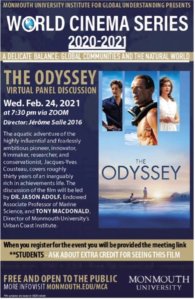 On February 24, the Institute for Global Understanding (IGU) co-hosted a virtual discussion of the film The Odyssey. Hosted by Dr. Thomas Pearson, Professor of History, the discussion featured UCI Director Tony MacDonald, Esq. and Dr. Jason Adolf, Associate Professor of Biology and Endowed Associate Professor of Marine Science. The virtual discussion was an invigorating and highly educational reflection on the current state of the oceans and how they impact human life and activities.
On February 24, the Institute for Global Understanding (IGU) co-hosted a virtual discussion of the film The Odyssey. Hosted by Dr. Thomas Pearson, Professor of History, the discussion featured UCI Director Tony MacDonald, Esq. and Dr. Jason Adolf, Associate Professor of Biology and Endowed Associate Professor of Marine Science. The virtual discussion was an invigorating and highly educational reflection on the current state of the oceans and how they impact human life and activities.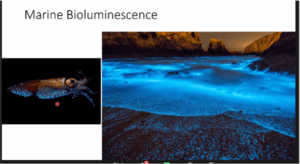 t, Dr. Jason Adolf offered his comments about the film and on oceanic research. He discussed how little is known about the ocean due to the lack of funding and exploration. As his research focus is on phytoplankton and light in the ocean, he discussed the technology that one would need to see and photograph the ocean at different depths, as well as the bioluminescence of marine life. With less light in the water at greater depths, there is less color in the environment. Additionally, there is a special bioluminescence in plankton and in other sea creatures, though little research is available. There is a wide variety of marine animals that use bioluminescence, but since humans can see blue light, the blue light disguises the special fluorescence.
t, Dr. Jason Adolf offered his comments about the film and on oceanic research. He discussed how little is known about the ocean due to the lack of funding and exploration. As his research focus is on phytoplankton and light in the ocean, he discussed the technology that one would need to see and photograph the ocean at different depths, as well as the bioluminescence of marine life. With less light in the water at greater depths, there is less color in the environment. Additionally, there is a special bioluminescence in plankton and in other sea creatures, though little research is available. There is a wide variety of marine animals that use bioluminescence, but since humans can see blue light, the blue light disguises the special fluorescence.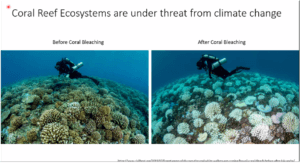 Dr. Adolf then explained how coral reefs are the most threatened marine habitats due to climate change. These reefs are susceptible to temperature change, as 90 percent of Earth’s excess heat is held at the oceans’ surface. As a result of rising temperatures, there will be a mass coral bleaching that will destroy all coral reefs.
Dr. Adolf then explained how coral reefs are the most threatened marine habitats due to climate change. These reefs are susceptible to temperature change, as 90 percent of Earth’s excess heat is held at the oceans’ surface. As a result of rising temperatures, there will be a mass coral bleaching that will destroy all coral reefs. The United Nations created World Wildlife Day in 2013 to promote awareness of wild animals and plants, as well as to celebrate these species. This commemorative day is celebrated on March 3. It is now recognized as the most important global annual event dedicated to the world’s wildlife. It draws attention to endangered species and the work that people around the world are doing to save these species and their ecosystems.
The United Nations created World Wildlife Day in 2013 to promote awareness of wild animals and plants, as well as to celebrate these species. This commemorative day is celebrated on March 3. It is now recognized as the most important global annual event dedicated to the world’s wildlife. It draws attention to endangered species and the work that people around the world are doing to save these species and their ecosystems.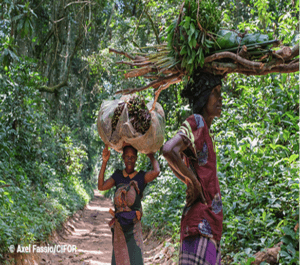 ildlife Day theme, “Forests and Livelihoods: Sustaining People and Planet,” focuses on how forests, and their species and ecosystems, help sustain people’s livelihoods. Forests affect indigenous peoples’ livelihoods more than any other ecosystem and help indigenous peoples meet their basic needs, including food, shelter, energy, and medicine.
ildlife Day theme, “Forests and Livelihoods: Sustaining People and Planet,” focuses on how forests, and their species and ecosystems, help sustain people’s livelihoods. Forests affect indigenous peoples’ livelihoods more than any other ecosystem and help indigenous peoples meet their basic needs, including food, shelter, energy, and medicine.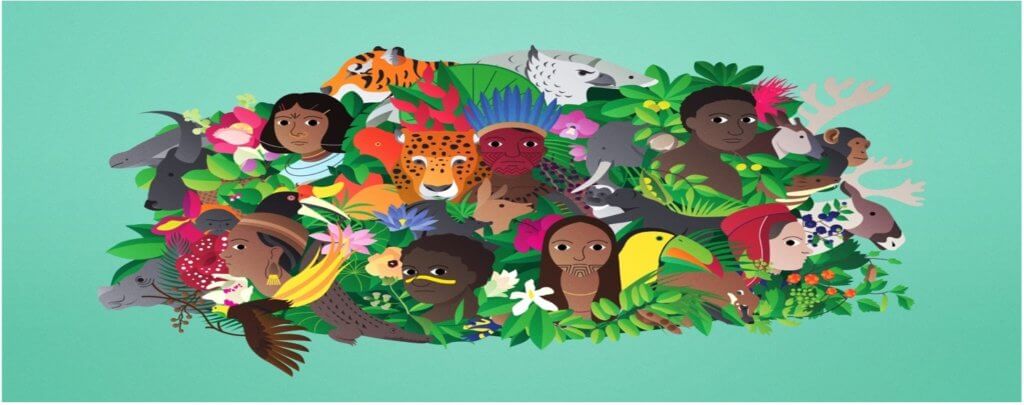
 On February 16, 2021, the Institute for Global Understanding (IGU) co-sponsored the Tuesday Night World Music Record Club’s discussion of Love Letters (2020), Anoushka Shankar’s most recent release. Nominated for a Grammy in the Best Global Music Album category, the EP consists of six songs: “Bright Eyes,” “Those Words,” “Lovable,” “Space,” “Wallet,” and “In This Mouth.” Dr. Meghan Hynson, Assistant Professor of Ethnomusicology, led participants through a thoughtful discussion spanning Shankar’s musical evolution as well as the intricacies of each Love Letters track. She contributed a substantive context to every song introduced, facilitating an immersive and collaborative listening experience for all in attendance.
On February 16, 2021, the Institute for Global Understanding (IGU) co-sponsored the Tuesday Night World Music Record Club’s discussion of Love Letters (2020), Anoushka Shankar’s most recent release. Nominated for a Grammy in the Best Global Music Album category, the EP consists of six songs: “Bright Eyes,” “Those Words,” “Lovable,” “Space,” “Wallet,” and “In This Mouth.” Dr. Meghan Hynson, Assistant Professor of Ethnomusicology, led participants through a thoughtful discussion spanning Shankar’s musical evolution as well as the intricacies of each Love Letters track. She contributed a substantive context to every song introduced, facilitating an immersive and collaborative listening experience for all in attendance. Without question, Love Letters showcases Shankar’s mastery of the sitar. Shankar’s father, legendary Indian musician Ravi Shankar, first introduced her to the instrument at the age of seven. By the time she turned thirteen, Shankar’s professional career had taken shape and she had already performed on stage and produced an album. As her musical prowess grew increasingly evident, she opted not to attend university and instead followed in her father’s footsteps as a musical pioneer and performer of the sitar.
Without question, Love Letters showcases Shankar’s mastery of the sitar. Shankar’s father, legendary Indian musician Ravi Shankar, first introduced her to the instrument at the age of seven. By the time she turned thirteen, Shankar’s professional career had taken shape and she had already performed on stage and produced an album. As her musical prowess grew increasingly evident, she opted not to attend university and instead followed in her father’s footsteps as a musical pioneer and performer of the sitar.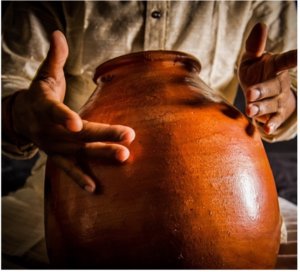 y quite well, for it functions, in Dr. Hynson’s words, as a “fascinating fusion of the sitar and a number of other musical instruments.” For example, the single, “Bright Eyes” integrates the ghatam, a traditional water pot percussion instrument that is played with the mouth pressed against the player’s stomach. The player taps the surface of the ghatam with the fingers and the base of the palm and changes the pitch and resonance of the instrument by varying the pressure of the pot against the stomach. In this way, the EP incorporates a classic Indian aesthetic of sitar, ghatam, kanjira, and tanpura with modern Western pop instrumentation, to create a hybrid sound appealing to a variety of listeners.
y quite well, for it functions, in Dr. Hynson’s words, as a “fascinating fusion of the sitar and a number of other musical instruments.” For example, the single, “Bright Eyes” integrates the ghatam, a traditional water pot percussion instrument that is played with the mouth pressed against the player’s stomach. The player taps the surface of the ghatam with the fingers and the base of the palm and changes the pitch and resonance of the instrument by varying the pressure of the pot against the stomach. In this way, the EP incorporates a classic Indian aesthetic of sitar, ghatam, kanjira, and tanpura with modern Western pop instrumentation, to create a hybrid sound appealing to a variety of listeners. Notably, Love Letters could not exist if not for the efforts of a host of trail-blazing women. The album featured a number of female musicians and writers, as well as a female musical engineer from Brooklyn, Heba Kadry. Ayanna Witter-Johnson plays the cello on the second track, “Those Words,” and Shilpa Rao (Indian vocals), Alev Lenz, Nina Harries, and twin sisters Ibeyi are all featured vocalists on the record. Their collaboration was integral to the EP’s creation, supporting Shankar both musically and spiritually. In reflecting on the EP’s production, Shankar explained, “I really got to experience the way women show up for each other when crisis strikes. That’s really where this music came from: the shared experience of women, holding my hand and helping me find a safe place to put some of my feelings.”
Notably, Love Letters could not exist if not for the efforts of a host of trail-blazing women. The album featured a number of female musicians and writers, as well as a female musical engineer from Brooklyn, Heba Kadry. Ayanna Witter-Johnson plays the cello on the second track, “Those Words,” and Shilpa Rao (Indian vocals), Alev Lenz, Nina Harries, and twin sisters Ibeyi are all featured vocalists on the record. Their collaboration was integral to the EP’s creation, supporting Shankar both musically and spiritually. In reflecting on the EP’s production, Shankar explained, “I really got to experience the way women show up for each other when crisis strikes. That’s really where this music came from: the shared experience of women, holding my hand and helping me find a safe place to put some of my feelings.”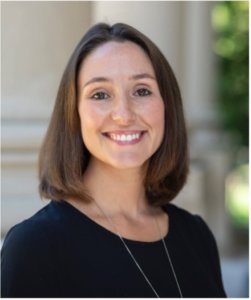 Love Letters signifies a departure from Shankar’s typical releases. Indeed, according to Dr. Hynson, the EP serves as “documentation of this profound period of upheaval” in Shankar’s recent history. From health issues to divorce, Shankar has grappled with losses that transcended her personal narrative and made their way into her songwriting. As a result, Love Letters emits a rather “somber,” “introspective,” and “cathartic” tone. At the same time, Shankar was careful not to craft her songs in an idiosyncratic manner, instead aiming for lyrics equally poignant and unspecific so that listeners could interpret her music in their own way. Therefore, Love Letters embodies a journey to healing, meeting listeners exactly where they are in hopes of elevating their spirits to some better place.
Love Letters signifies a departure from Shankar’s typical releases. Indeed, according to Dr. Hynson, the EP serves as “documentation of this profound period of upheaval” in Shankar’s recent history. From health issues to divorce, Shankar has grappled with losses that transcended her personal narrative and made their way into her songwriting. As a result, Love Letters emits a rather “somber,” “introspective,” and “cathartic” tone. At the same time, Shankar was careful not to craft her songs in an idiosyncratic manner, instead aiming for lyrics equally poignant and unspecific so that listeners could interpret her music in their own way. Therefore, Love Letters embodies a journey to healing, meeting listeners exactly where they are in hopes of elevating their spirits to some better place. The next speaker, Dr. Samira Idllalène, addressed how the “atmospheric waqf principle” can be applied to the marine environment to respond to climate change impacts. Dr. Idllalène stated that the atmospheric waqf principle is a belief in the Muslim religion that values the idea of trusteeship and can be utilized in a way to respect animals and the natural environment to which they belong. She supported her argument by noting that waqf is an existing legal tool in Muslim countries as well as an ancestral institution with ecological applications. Moreover, “[T]here is a growing spiritual ecology movement happening across the globe, and atmospheric waqf allows animals additional protections by ensuring climate change does not affect their environment.”
The next speaker, Dr. Samira Idllalène, addressed how the “atmospheric waqf principle” can be applied to the marine environment to respond to climate change impacts. Dr. Idllalène stated that the atmospheric waqf principle is a belief in the Muslim religion that values the idea of trusteeship and can be utilized in a way to respect animals and the natural environment to which they belong. She supported her argument by noting that waqf is an existing legal tool in Muslim countries as well as an ancestral institution with ecological applications. Moreover, “[T]here is a growing spiritual ecology movement happening across the globe, and atmospheric waqf allows animals additional protections by ensuring climate change does not affect their environment.”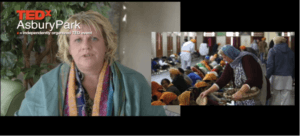 Dr. Jodry shared her passion for service during an intimate discussion of her first meeting with Courtney Deacon Lalotra, the founder of One Life to Love, a nonprofit organization and orphanage that provides education, nutrition, and health care to migrant children with mental and physical disabilities in New Delhi, India. A mutual friend introduced Dr. Jodry to Ms. Deacon Lalotra shortly after Dr. Jodry received a cancer diagnosis in 2015 that she says created “a new identity” for her, leaving her “more fearful.” Ms. Deacon Lalotra’s selfless and courageous devotion to offering basic necessities, love, and care to children of the greatest need inspired Dr. Jodry to find meaning and healing in service.
Dr. Jodry shared her passion for service during an intimate discussion of her first meeting with Courtney Deacon Lalotra, the founder of One Life to Love, a nonprofit organization and orphanage that provides education, nutrition, and health care to migrant children with mental and physical disabilities in New Delhi, India. A mutual friend introduced Dr. Jodry to Ms. Deacon Lalotra shortly after Dr. Jodry received a cancer diagnosis in 2015 that she says created “a new identity” for her, leaving her “more fearful.” Ms. Deacon Lalotra’s selfless and courageous devotion to offering basic necessities, love, and care to children of the greatest need inspired Dr. Jodry to find meaning and healing in service.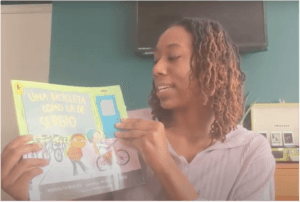 Ultimately, Marshall identified a need for virtual storytelling content that would provide Spanish-speaking children with educational resources during the library’s closure. Given the growing immigrant populations within Long Branch and in nearby towns, many families increasingly rely on such resources to help their children successfully navigate school systems in which the language of instruction differs from their primary languages spoken at home. With this in mind, Marshall suggested that each Monmouth student select a children’s book written in Spanish from the library’s collection so that they could practice reading and performing the story. After working on their oral presentations throughout the semester, students would then record themselves reading the stories and upload these videos to the library’s webpage and YouTube account for local children and their families to view remotely.
Ultimately, Marshall identified a need for virtual storytelling content that would provide Spanish-speaking children with educational resources during the library’s closure. Given the growing immigrant populations within Long Branch and in nearby towns, many families increasingly rely on such resources to help their children successfully navigate school systems in which the language of instruction differs from their primary languages spoken at home. With this in mind, Marshall suggested that each Monmouth student select a children’s book written in Spanish from the library’s collection so that they could practice reading and performing the story. After working on their oral presentations throughout the semester, students would then record themselves reading the stories and upload these videos to the library’s webpage and YouTube account for local children and their families to view remotely.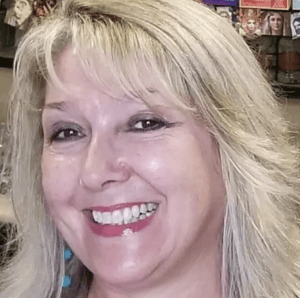 Notably, this exercise entailed immense benefits for the project’s student participants, challenging them to refine their oral communication skills for a purpose greater than themselves. As Dr. Maginn explained, “Storytelling is quite a task, even in your own language. You have to really practice enunciating clearly and delivering a bit of dramatization so that the story is accessible for little kids.” Moreover, the project demonstrated how foreign language instruction functions as a critical component of promoting global understanding. In Dr. Maginn’s words, “Language is never just language: language is language and culture. So, when students study language at Monmouth, they are always studying a language in context, and one of the big things we emphasize in language instruction is that there are both similarities and differences amongst cultures that we should embrace rather than be afraid of… Whether it be through readings, videos, or live discussions with native speakers, we encourage students to engage in critical thinking and to move beyond initial gut reactions, and language allows us to do this so well because it necessitates that one try to understand things that may be different from what they’re used to.”
Notably, this exercise entailed immense benefits for the project’s student participants, challenging them to refine their oral communication skills for a purpose greater than themselves. As Dr. Maginn explained, “Storytelling is quite a task, even in your own language. You have to really practice enunciating clearly and delivering a bit of dramatization so that the story is accessible for little kids.” Moreover, the project demonstrated how foreign language instruction functions as a critical component of promoting global understanding. In Dr. Maginn’s words, “Language is never just language: language is language and culture. So, when students study language at Monmouth, they are always studying a language in context, and one of the big things we emphasize in language instruction is that there are both similarities and differences amongst cultures that we should embrace rather than be afraid of… Whether it be through readings, videos, or live discussions with native speakers, we encourage students to engage in critical thinking and to move beyond initial gut reactions, and language allows us to do this so well because it necessitates that one try to understand things that may be different from what they’re used to.” Despite Monmouth students’ inability to meet the children for whom they read, their participation in the project greatly enhanced both their Spanish-speaking skills and connection to Monmouth’s surrounding communities. When recalling her experiences while completing the project, freshman Isabella Leak detailed, “Every day, I would go through my story and practice enunciating all of the words to make sure that I would be able to speak clearly for the kids on the video… Just by reading the book, practicing the vocabulary, and making sure my accent was good, my Spanish improved… but I also developed a greater understanding of how Spanish connects us to our community and to other people.” Though facilitating such connection during a pandemic may seem daunting, the service-learning experience proved a remarkable success, with Leak concluding that, “This project definitely opened my eyes and made me realize how lucky people who speak English as their first language are, and I think we overlook that privilege and do not really acknowledge it. However, it’s really important for us as students to understand that point… being able to teach [Spanish] and connect to other people was my biggest takeaway; I really learned the value of language and connection with other people.”
Despite Monmouth students’ inability to meet the children for whom they read, their participation in the project greatly enhanced both their Spanish-speaking skills and connection to Monmouth’s surrounding communities. When recalling her experiences while completing the project, freshman Isabella Leak detailed, “Every day, I would go through my story and practice enunciating all of the words to make sure that I would be able to speak clearly for the kids on the video… Just by reading the book, practicing the vocabulary, and making sure my accent was good, my Spanish improved… but I also developed a greater understanding of how Spanish connects us to our community and to other people.” Though facilitating such connection during a pandemic may seem daunting, the service-learning experience proved a remarkable success, with Leak concluding that, “This project definitely opened my eyes and made me realize how lucky people who speak English as their first language are, and I think we overlook that privilege and do not really acknowledge it. However, it’s really important for us as students to understand that point… being able to teach [Spanish] and connect to other people was my biggest takeaway; I really learned the value of language and connection with other people.” In short, Dr. Maginn’s course allowed Monmouth University students to practically apply their Spanish language skills while promoting awareness and understanding of Spanish-speaking communities in and around West Long Branch. Ultimately, its model of community-driven work could be a steppingstone toward a substantive addition to Monmouth University. The project reinforced her students’ language skills, all while granting them new experiences that helped them grow as people and empowering the communities around them. Following this lead, service-learning practitioners should seriously consider adopting similar approaches and understand that rich cross-cultural connections are possible and transpiring daily, even in the midst of a pandemic.
In short, Dr. Maginn’s course allowed Monmouth University students to practically apply their Spanish language skills while promoting awareness and understanding of Spanish-speaking communities in and around West Long Branch. Ultimately, its model of community-driven work could be a steppingstone toward a substantive addition to Monmouth University. The project reinforced her students’ language skills, all while granting them new experiences that helped them grow as people and empowering the communities around them. Following this lead, service-learning practitioners should seriously consider adopting similar approaches and understand that rich cross-cultural connections are possible and transpiring daily, even in the midst of a pandemic. nd a specialist in global communications.
nd a specialist in global communications. Dr. Naik provided viewers with an explanation of what happened logistically regarding the Union Carbide product’s toxicity and why it had killed so many people in Bhopal in 1984. To begin, Union Carbide was making and selling a toxic pesticide, Sevine, made from MIC (methyl isocyanate), which was made at the plant, and 1-naphthol, which was outsourced from another location. The chemical compound MIC is extremely toxic; the threshold limit value set by the American Conference on Government Industrial Hygienists is 0.02 parts per million (ppm). Although the MIC’s odor cannot be detected at 5 ppm by most people, its potent lachrymal properties provide an excellent warning of its presence. (At 2-4 ppm, subjects’ eyes are irritated, the first sign of exposure.)
Dr. Naik provided viewers with an explanation of what happened logistically regarding the Union Carbide product’s toxicity and why it had killed so many people in Bhopal in 1984. To begin, Union Carbide was making and selling a toxic pesticide, Sevine, made from MIC (methyl isocyanate), which was made at the plant, and 1-naphthol, which was outsourced from another location. The chemical compound MIC is extremely toxic; the threshold limit value set by the American Conference on Government Industrial Hygienists is 0.02 parts per million (ppm). Although the MIC’s odor cannot be detected at 5 ppm by most people, its potent lachrymal properties provide an excellent warning of its presence. (At 2-4 ppm, subjects’ eyes are irritated, the first sign of exposure.) Next, MIC was created in large quantities at the Union Carbide plant and needed to be kept cool (near the freezing point) when not in use, which was the case in Bhopal. The chemical was then kept in large 60-ton tanks while waiting to be utilized properly. The chemical leak started from these storage tanks due to lack of specific protocols being followed, as well as the event itself, which was the MIC reacting with other chemicals and escaping into the atmosphere. Several protocols were not followed: (1) the tank’s refrigeration was off, (2) one out of the three tanks was empty, and (3) the other two tanks
Next, MIC was created in large quantities at the Union Carbide plant and needed to be kept cool (near the freezing point) when not in use, which was the case in Bhopal. The chemical was then kept in large 60-ton tanks while waiting to be utilized properly. The chemical leak started from these storage tanks due to lack of specific protocols being followed, as well as the event itself, which was the MIC reacting with other chemicals and escaping into the atmosphere. Several protocols were not followed: (1) the tank’s refrigeration was off, (2) one out of the three tanks was empty, and (3) the other two tanks  were filled more than halfway (~30 tons of MIC). The chemical reaction that took place was due to an operation error during the rinsing of the vent pipes; water flowed into the MIC storage tank, which is when everything started to go wrong. An exothermic reaction between MIC and water occurred, producing intense heat in the tank’s confined space. The temperature and pressure started to rise, which caused part of the MIC distillates to decompose and to generate hydrogen chloride gas. This gas formed hydrochloric acid with water (another exothermic reaction) and corroded the stainless-steel tank, dissolving it into iron. The dissolved iron, acting as a catalyst, caused a trimerization reaction to produce trimethyl isocyanate (a solid). This trimerization reaction did not go into the atmosphere, but rather was exothermic and produced extreme heat, which simply increased the temperature and pressure in the tank, reaching 250 °C (482 °F), causing the tanks to rupture. Eventually, the toxic MIC gas along with several other toxic gases, all heavier than air, leaked out of the tank and into the plant, and then finally into the low atmosphere of Bhopal.
were filled more than halfway (~30 tons of MIC). The chemical reaction that took place was due to an operation error during the rinsing of the vent pipes; water flowed into the MIC storage tank, which is when everything started to go wrong. An exothermic reaction between MIC and water occurred, producing intense heat in the tank’s confined space. The temperature and pressure started to rise, which caused part of the MIC distillates to decompose and to generate hydrogen chloride gas. This gas formed hydrochloric acid with water (another exothermic reaction) and corroded the stainless-steel tank, dissolving it into iron. The dissolved iron, acting as a catalyst, caused a trimerization reaction to produce trimethyl isocyanate (a solid). This trimerization reaction did not go into the atmosphere, but rather was exothermic and produced extreme heat, which simply increased the temperature and pressure in the tank, reaching 250 °C (482 °F), causing the tanks to rupture. Eventually, the toxic MIC gas along with several other toxic gases, all heavier than air, leaked out of the tank and into the plant, and then finally into the low atmosphere of Bhopal. Lastly, due to misinformation and lack of education regarding the chemicals being held and produced at Union Carbide, essential workers, staff members, and even the local community knew nothing about how to treat the symptoms that were present during the gas leak. Also, Union Carbide had not conducted emergency drill or training prior to the incident, which is unfortunate because all that needed to be done to escape the inhalation of the toxic gas was to run to higher ground. Therefore, due to lack of education and training, thousands of people were then greatly affected by this horrific event. In fact, the official immediate death toll was 2,259. Then, in 1991, after being reassessed, the total count was 3,928 deaths. However, unofficial total deaths are estimated to be around 14,410. Also, the amount of people injured during this event is estimated to be 574,000. To put this into perspective, Bhopal’s population in 1984 was 850,00; therefore, over half of the population was affected. Overall, there were many potential efforts that could have prevented this disaster.
Lastly, due to misinformation and lack of education regarding the chemicals being held and produced at Union Carbide, essential workers, staff members, and even the local community knew nothing about how to treat the symptoms that were present during the gas leak. Also, Union Carbide had not conducted emergency drill or training prior to the incident, which is unfortunate because all that needed to be done to escape the inhalation of the toxic gas was to run to higher ground. Therefore, due to lack of education and training, thousands of people were then greatly affected by this horrific event. In fact, the official immediate death toll was 2,259. Then, in 1991, after being reassessed, the total count was 3,928 deaths. However, unofficial total deaths are estimated to be around 14,410. Also, the amount of people injured during this event is estimated to be 574,000. To put this into perspective, Bhopal’s population in 1984 was 850,00; therefore, over half of the population was affected. Overall, there were many potential efforts that could have prevented this disaster. Dr. Vujnovic helped viewers better understand Union Carbide’s failure to exercise responsibility (now called Dow Chemical Company) for this event that occurred more than three decades ago. She also explained how the attitude portrayed toward this disaster, along with the lack of a coordinated response, shows exactly how not to do crisis management: “delayed, denied, and deflected.” The story of Bhopal is simply about collusion between governments (both Indian and American), along with large corporate powers. The groups involved continue to obstruct justice for the Bhopal disaster’s victims due to lack of enforcement regarding liability. For example, even today, the company continues to refuse to provide basic information regarding the disaster to reporters, constantly giving excuses and blaming the local government as well as the Bhopal community for the crisis. However, legal documentation indicates that everything is traced back to Warren Anderson, the former CEO of Union Carbide. Anderson had signed the paperwork knowing that there would be safety issues at the Bhopal location simply for the purpose of cost-saving measures. The documents eventually surfaced in 1981 proving this, along with the number of employees hired and fired, as well as the lack of safety training protocols throughout the company’s locations.
Dr. Vujnovic helped viewers better understand Union Carbide’s failure to exercise responsibility (now called Dow Chemical Company) for this event that occurred more than three decades ago. She also explained how the attitude portrayed toward this disaster, along with the lack of a coordinated response, shows exactly how not to do crisis management: “delayed, denied, and deflected.” The story of Bhopal is simply about collusion between governments (both Indian and American), along with large corporate powers. The groups involved continue to obstruct justice for the Bhopal disaster’s victims due to lack of enforcement regarding liability. For example, even today, the company continues to refuse to provide basic information regarding the disaster to reporters, constantly giving excuses and blaming the local government as well as the Bhopal community for the crisis. However, legal documentation indicates that everything is traced back to Warren Anderson, the former CEO of Union Carbide. Anderson had signed the paperwork knowing that there would be safety issues at the Bhopal location simply for the purpose of cost-saving measures. The documents eventually surfaced in 1981 proving this, along with the number of employees hired and fired, as well as the lack of safety training protocols throughout the company’s locations. Another example of corruption is the settlement to which Union Carbide agreed with the U.S. and Indian governments. The company agreed to this settlement to save its image and reputation, but the money was given to the Indian government to provide each victim and family with proper compensation (around $1,000 per victim). However, the Indian government enacted the Bhopal Gas Leak Disaster Act in 1985, which enabled the government to act as a legal representative for the victims. Therefore, once this money was paid, the Indian government did not give all the money to the victims and instead kept most of the estimated $370 million in its own coffers. The victims and their families continue to campaign in the hope that they will one day receive proper compensation for the disaster.
Another example of corruption is the settlement to which Union Carbide agreed with the U.S. and Indian governments. The company agreed to this settlement to save its image and reputation, but the money was given to the Indian government to provide each victim and family with proper compensation (around $1,000 per victim). However, the Indian government enacted the Bhopal Gas Leak Disaster Act in 1985, which enabled the government to act as a legal representative for the victims. Therefore, once this money was paid, the Indian government did not give all the money to the victims and instead kept most of the estimated $370 million in its own coffers. The victims and their families continue to campaign in the hope that they will one day receive proper compensation for the disaster. On a more positive note, although there was a lack of global support and attention given to the Bhopal disaster, a nonprofit organization, the Chingari Trust, continues to help combat the disaster’s effects on the local community. Founded by survivors Rashida Bee and Champadevi Shukla in 2006, the organization provides economic and livelihood support programs primarily to women and children in the affected area.
On a more positive note, although there was a lack of global support and attention given to the Bhopal disaster, a nonprofit organization, the Chingari Trust, continues to help combat the disaster’s effects on the local community. Founded by survivors Rashida Bee and Champadevi Shukla in 2006, the organization provides economic and livelihood support programs primarily to women and children in the affected area.